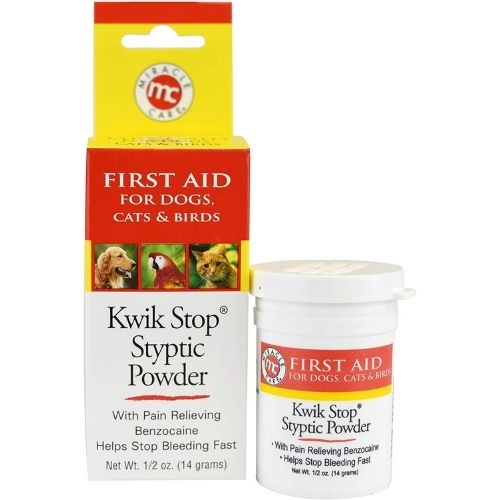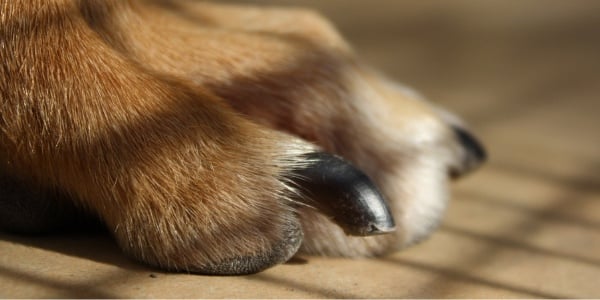
Most people love getting manicures and pedicures. Dogs, not so much! But if we can create the same relaxing and positive experience for our dogs as we get at the salon, they may grow to love it — or at least tolerate it.
Check out our article How to Get Your Dog Used to Nail Trims for tips to help your dog if they are nervous about getting their nails done.
Creating the right ambiance includes developing confidence in your ability to trim your dog's nails properly (remember, dogs will notice when you're nervous) and knowing what essentials are needed to make it a good experience. But one of the questions I get asked most often about dog nails is how often should they be trimmed?
How Often Should You Clip Your Dog's Nails?
Cutting your dog's nails frequently will cause the quick to recede and allow the nails to be trimmed shorter. So, if it's possible and practical to trim your dog's nails weekly or at least every other week, you'll likely see better results, have a much less stressed dog, and experience less stress yourself in the process.
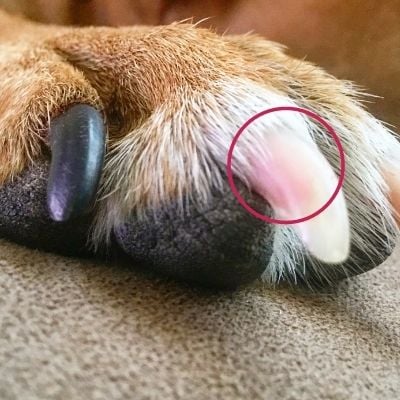
A good rule of thumb is that you should trim your dog's nails or have them trimmed as often as it takes to prevent their nails from touching the ground when they're standing (just like in the photo at the top of this article).
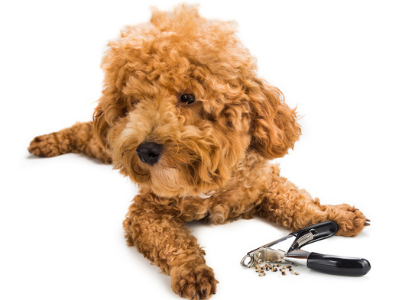 While this frequency will be different for each dog, there are some other factors that affect how often you need to clip your dog's nails:
While this frequency will be different for each dog, there are some other factors that affect how often you need to clip your dog's nails:
- The type of surface your dog spends most of their time on: Are they indoors mostly and only touching carpet? Outdoors on grass, dirt, or concrete pad? Do they spend most of their day in your arms or on the couch? Or do they go for frequent walks on asphalt or concrete? The harder the surface they walk on most of the time, the more their nails will wear down.
- The type of activities they do: Do they dig? Do they do agility or other sports? Same as the surfaces they walk on, certain activities wear down dog nails more.
- What your dog eats: Your dog's nutrition, particularly the balance of certain minerals and vitamins, can have an impact on the health and growth rate of your dog's nails. If your dog is well nourished, their nails are typically stronger and less brittle.
- Certain health conditions: Dogs can get nail bed bacterial infections, fungal infections, auto-immune disorders, food and environmental allergies, and tumors that can affect the health and growth rate of their nails.
What to Do if You Cut Your Dog's Nail Too Short
Aim to take enough off of each nail to keep it short, yet not so much that you cut the quick (blood supply) or the nerve endings that extend just beyond the leading edge of the quick. You might hear this referred to as "quicking" your dog's nails. This happens when you cut the blood vessel (called the quick), and it happens more frequently with dogs that squirm a lot during nail trims, as well as with dogs with black nails because it is easier to see the quick in dogs with clear nails.
Should you ever cut your dog’s nails too short — which many people, including professionals, have done — you'll want to have something on hand to stop the bleeding. Always keep something on hand to stop the bleeding, including a towel, and have it beside you when trimming, as the quick can bleed quite a lot when cut.
You can use styptic powder like Kwik-Stop. In a pinch, though, you can also use cornstarch pressed onto the nail and hold for a few minutes to stop the nail from bleeding.
Check out our list of vet-recommended items to put in your dog's first-aid kit.

Cutting the nail at the correct angle will prevent hitting the quick but also helps create the shortest nail possible. Trimming to create a rollover is important as well. The "rollover" is the rounding of the nail, so it "rolls over" as your dog walks. If the angle of the nail is cut incorrectly or too much of a point is left, then it should be rounded out with a Dremel or a nail file. You can use a regular household nail file strong enough for toenails or a nail file specifically made for dogs, which typically has a better handle to grip and apply pressure.
Trimming slowly and vertically on both the top and bottom of the nail as well as the sides a bit allows you to avoid the quick by visualizing it sooner. It's important to go slowly and give your dog lots of praise and positive rewards (treats) throughout the process.
NOTE: Remember to wipe off the nail "remnants” as you slowly trim so you can visualize the quick and see how much you've taken off more easily.
Why You Don't Want to Let Your Dog's Nails Get Too Long
- Long nails can actually be painful for your dog when they strike the pavement or floor with each step.
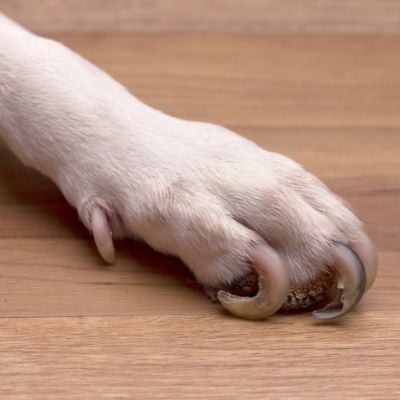
- Long nails affect your dog’s gait and posture, which in turn can cause pain and inflammation in their joints.
- Long nails can make it difficult for your dog to have a good grip as they walk on slick floors like hardwood and tile. This is especially concerning for older dogs. If they splay their legs repeatedly, this can cause trauma to their joints and muscles or worsen arthritic conditions.
- Long nails can split, exposing the quick. The exposed quick can become infected.
- Untrimmed nails can curl and grow into your dog's skin or paw pads, resulting in an infection and pain. This is true of all nails, but especially the dewclaws.
- Long nails are more likely to get hung up on things and torn off. If your dog is especially active, this could cause them injury.
- Long nails can cut into your skin when you're handling them. This is especially problematic for people who have thin skin, are on blood thinners, or are immunocompromised. The sharp nails can cut the skin, and bleeding can be difficult to stop. Dog’s nails can retain all kinds of bacteria and fungi from their environment and from their mouths. These can be transferred to humans through scratches from their nails. When this happens to elderly or immunocompromised individuals, serious infections can result.
- And then there's the damage that long nails can do to your floors and furniture.
Peeling, Chipping, and Brittle Nails: Why it Happens
Trimming your dog’s nails when they are ‘normal’ and ‘healthy’ can be stressful enough. But this event can seem more troublesome when you notice that their nails seem brittle and chip, break, or peel when cut. Don’t panic; we are here to help you understand what is happening and what you must do next.
Why Dog Nails Peel, Chip, or Are Brittle
There are a few different answers to this question. Some causes are due to the nails themselves, while others may indicate other medical issues.
- Trauma/Injury: Dogs put their nails through A LOT with walking, running, playing, and digging. These actions can cause a piece, a part, or the whole nail to come off. Depending on the extent of the nail that breaks off, the location of the break, and if the quick is exposed determines if you need to see your vet or not. When the nail bed (where the nail and skin meet) is unharmed and/or the quick is not exposed, you generally don’t need to be concerned. But if the nail bed is swollen and the quick is exposed, it is best to consult your veterinarian.
- Nutritional issues: Keratin, which is composed of over 90% protein, is what makes up the outside of the nail. The protein needed to make keratin comes from the protein in your dog’s diet. Brittle nails can be the result of a nutritional issue. If you are feeding your dog a high-quality, well-balanced diet, then the issue may be that your dog isn’t properly absorbing nutrients. I recommend speaking to your veterinarian to see what diagnostics or supplements may be needed.
- Nail infections: Your dog can have bacterial and/or fungal nail infections. There are several causes of both (prior trauma, allergies – food or environmental, ringworm). If you notice the skin around the nailbed is red or swollen, or the nail and the skin are crusty looking, consult with your veterinarian. They will need to examine your dog thoroughly and perform diagnostic tests to determine the cause of your dog’s nail issues.
Some terms that are helpful to know:
Paronychia: Inflammation of the skin around the nail. This can occur with or without infection.Onychomycosis: Term used when there is a fungal infection of the nail.
Lupoid Onychodystrophy: This is an immune-mediated nail disorder. It can cause your dog’s nails to be brittle, misshapen, thickened as well as fall off. Fortunately, this isn’t a very common condition. Breeds predisposed to it include:
- Rottweilers
- German Shepherds
- Siberian Husky
- Miniature Schnauzers
- Labrador Retrievers
- Greyhounds
- Golden Retrievers
Dogs predisposed to allergies that may have nail issues include:
- Golden Retrievers
- Labrador Retrievers
- West Highland White Terriers
- Terrier breeds
- Bichon Frise
- Maltese
- German Shepherds
- Can affect many other breeds as well
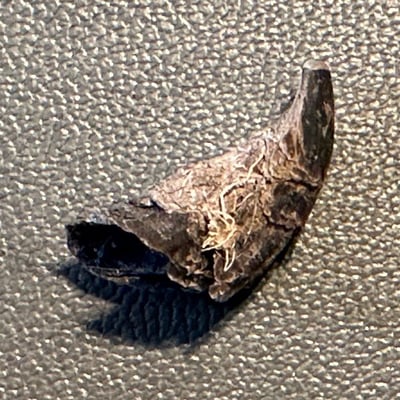 Dog Nail Falls Off!
Dog Nail Falls Off!
There are cases where you may find a whole nail on the floor (like the one in the photo, which was from a dewclaw nail). But when you check all your dog's nails, they look fine. This can happen when dirt and fur get caught around the nail creating a ‘solid cover,’ and it pulls off the outer layer. Similar to when our nails break and peel. This can happen when your dog is licking or chewing at the nail or if it gets snagged on something.
Note: Older pets tend to have drier nails, and they tend to be more brittle and break more easily. Therefore, it is especially important to trim older dogs’ nails regularly. When nails are extremely brittle, it is called onychorrhexis.
Anytime your dog is licking, biting, or chewing on their nails, be sure to inspect their nails, nailbed, and paw closely. This is typically an indicator that something isn’t right.
How to Give Your Dog More Traction
Regardless of the length of your dog's nails, some dogs just have a harder time getting traction on certain surfaces, like tile, linoleum, and hardwood. This is especially true for a dog with arthritis or poor muscling (muscle loss or weakness from lack of use).
For dogs with traction problems that can't be solved by just nail trimming alone, there are several solutions you may consider. Each solution has its pros and cons. Trying the one that you feel your dog will tolerate the most is the best place to start. Trial and error is, unfortunately, part of the process, but below are some of our recommended choices, as many of our team members and my patients in the past have used them.
Doggie Socks
Note that the main concern with socks is that, depending on the brand/style, the size of your dog, and their activity level, the socks may twist, fall down, or come off. And depending on the dog, they may eat them. We provide some sock product recommendations in our arthritis and mobility article, as several Preventive Vet team members' dogs have used various brands.
Anti-Slip Grips
Some dogs do well with adding coverings to their pads, such as PawFriction or Anti Slip Paw Grips. 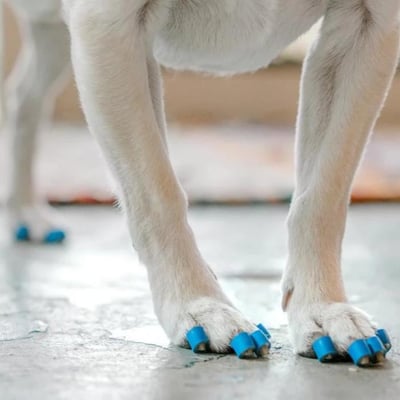
I've also found that Dr. Busby's ToeGrips are a great alternative way to help your dog get a grip on slippery floors.
With any of these solutions, make sure to order the correct size for socks and toe grips. Also, take the time to get your dog accustomed to wearing them and monitor them during the initial phase of use, so they're less likely to try and pull them off or tamper with them. Make the experience of wearing something new enjoyable by pairing it with their favorite treats or toys.
Sometimes starting by using them on the hind legs first can greatly help with stability and your dog getting used to wearing them.
You can watch this video to see how easy it is to teach your dog to love wearing their boots.
Read our dog mobility article for more mobility tips and solutions.



